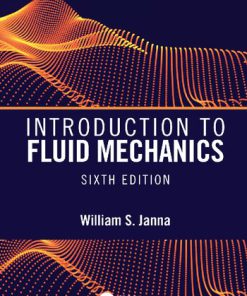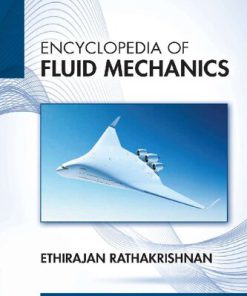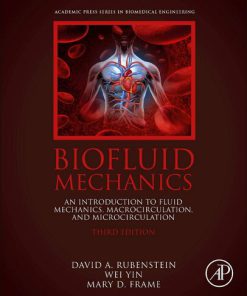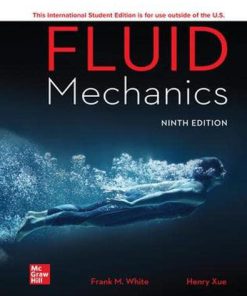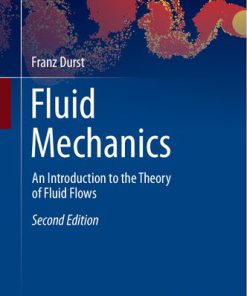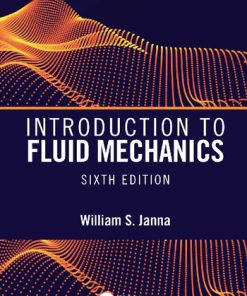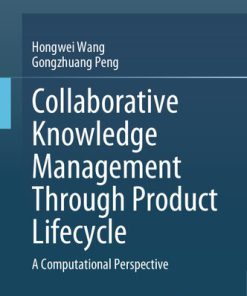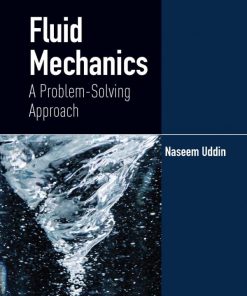A Guide to Fluid Mechanics 1st Edition by Hongwei Wang 1108498833 9781108498838
$50.00 Original price was: $50.00.$25.00Current price is: $25.00.
A Guide to Fluid Mechanics 1st Edition by Hongwei Wang- Ebook PDF Instant Download/Delivery: 1108498833, 9781108498838
Full download A Guide to Fluid Mechanics 1st Edition after payment
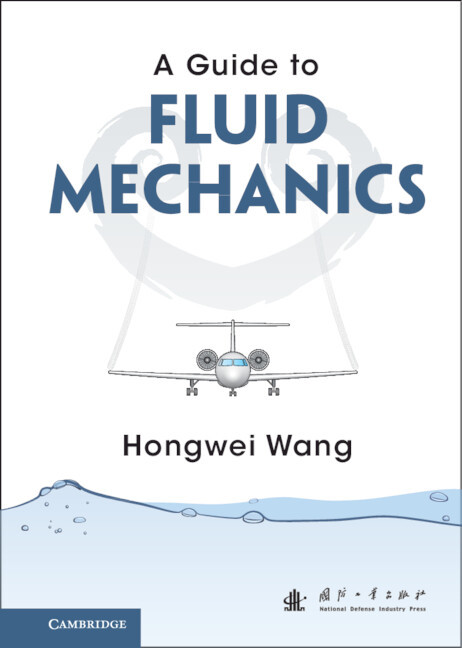
Product details:
ISBN 10: 1108498833
ISBN 13: 9781108498838
Author: Hongwei Wang
This book is written for the learner’s point of view, with the purpose of helping readers understand the principles of flow. The theory is explained using ordinary and accessible language, where fluid mechanics is presented in analogy to solid mechanics to emphasize that they are all the application of Newtonian mechanics and thermodynamics. All the informative and helpful illustrations are drawn by the author, uniting the science and the art with figures that complement the text and provide clear understanding. Another unique feature is that one of the chapters is wholly dedicated to providing 25 selected interesting and controversial flow examples, with the purpose of linking theory with practice. The book will be useful to both beginners in the field and experts in other fields, and is ideal for college students, graduate students, engineers, and technicians.
A Guide to Fluid Mechanics 1st Table of contents:
1 Fluids and Fluid Mechanics
1.1 Fluids: Basic Concepts
1.2 Some Properties of Fluids
1.2.1 Viscosity of Fluids
1.2.2 Surface Tension of Liquids
1.2.3 Equation of State for Gases
1.2.4 Compressibility of Gases
1.2.5 Thermal Conductivity of Gases
1.3 The Concept of Continuum
1.4 Forces in a Fluid
Expanded Knowledge
States of Matter
Compressibility of Water
Compressibility of Solids
Questions
2 Forces in a Static Fluid
2.1 Analysis of Forces in a Static Fluid
2.2 Pressure in a Static Fluid under the Action of Gravity
2.3 Pressure in a Fluid under the Action of Inertial Forces
2.4 Differences and Similarities in the Transfer of Force by Fluids and Solids
Expanded Knowledge
Atmospheric Pressure
Pressure Measurement
Questions
3 Description of Fluid Motion
3.1 Methods of Describing Fluid Motion
3.2 Pathlines and Streamlines
3.3 Velocity, Acceleration, and Substantial Derivative
3.4 Reynolds Transport Theorem
3.5 Relationship between the Reynolds Transport Theorem and Substantial Derivative
3.6 The Incompressibility Hypothesis
3.7 Motion and Deformation of a Fluid Element
3.7.1 Linear Deformation of a Fluid Element
3.7.2 Rotation of a Fluid Element
3.7.3 Angular Deformation of a Fluid Element
Expanded Knowledge
Streaklines and Their Applications
Streamline Coordinates
Questions
4 Basic Equations of Fluid Dynamics
4.1 Integral and Differential Approach
4.2 Continuity Equation
4.2.1 Continuity Equation: Integral Form
4.2.2 Conversion from Integral to Differential Equation
4.2.3 Differential Equation for an Elemental Control Volume
4.3 Momentum Equation
4.3.1 Integral Form of the Momentum Equation
4.3.2 Differential Momentum Equation
4.4 Bernoulli’s Equation
4.5 Angular Momentum Equation
4.5.1 Integral Angular Momentum Equation
4.5.2 Differential Angular Momentum Equation
4.6 Energy Equation
4.6.1 Integral Energy Equation
4.6.2 Differential Energy Equation
4.6.3 Equations of Enthalpy, Entropy, Total Enthalpy, and Shaft Work
4.7 Solution of the Governing Equations
4.7.1 Boundary Conditions
4.7.2 Some Analytical Solutions of N-S Equations
4.7.2.1. Couette Flow
4.7.2.2. Hagen–Poiseuille Flow
Expanded Knowledge
A Comparison between Constitutive Equations for Fluids and Solids
Mathematical Properties of N-S Equations
Solving Flow Problems
Questions
5 Inviscid Flow and Potential Flow Method
5.1 Characteristics of Inviscid Flow
5.2 Inviscid Rotational Flow
5.2.1 Vorticity Generated by Viscous Force
5.2.2 Vorticity Generation in Baroclinic Flow
5.2.3 Vorticity Generation with Nonconservative Body Forces
5.3 Irrotational Flow and Velocity Potential
5.4 Planar Potential Flow
5.4.1 Uniform Flow
5.4.2 Point Source and Point Sink
5.4.3 Point Vortex
5.4.4 Dipole
5.4.5 Uniform Flow Around a Circular Cylinder
5.5 Complex Potential
5.5.1 A More Concise Expression
5.5.2 Conformal Transformations
5.5.3 The Method of Images
5.6 Engineering Applications of Potential Flow and Its Current Status
Expanded Knowledge
Complex Variable Functions and Fluid Mechanics
Questions
6 Viscous Shear Flow
6.1 Shearing Motion and Flow Patterns of Viscous Fluids
6.2 Laminar Boundary Layer
6.2.1 Prandtl’s Boundary Layer Equations for Two-Dimensional Flows
6.2.2 Boundary Layer Thickness
6.2.3 Integral Approach for Solving Boundary Layer Problems
6.2.3.1 Momentum into and out of the Control Volume
6.2.3.2 Forces Acting on the Control Volume
6.3 Turbulent Boundary Layer
6.4 Pipe Flow
6.4.1 Entrance Region
6.4.2 Fully Developed Region
6.5 Jets and Wakes
6.5.1 Jets
6.5.2 Wake
6.6 Boundary Layer Separation
6.7 Drag and Losses
6.7.1 Drag
6.7.2 Flow Losses
6.7.2.1 Flow Losses in a Pipe with Constant Cross-Sectional Area
6.7.2.2 Flow Losses in a Pipe with Sudden Expansion
6.7.2.3 Losses in the Wake
Expanded Knowledge
The Theory of Homogeneous Isotropic Turbulence
Numerical Computation of Turbulent Flows
Turbulent Boundary Layer Separation
Questions
7 Fundamentals of Compressible Flow
7.1 Sound Speed and Mach Number
7.1.1 Speed of Sound
7.1.2 Mach Number
7.2 Steady Isentropic Flow Equations
7.2.1 Static and Total Parameters
7.2.2 Critical State and Coefficient of Velocity
7.2.3 Gasdynamic Functions
7.3 Expansion Wave, Compression Wave, and Shock Wave
7.3.1 Pressure Waves in Fluids
7.3.2 Normal Shock Wave
7.3.3 Oblique Shock Wave
7.4 Isentropic Flow in a Variable Cross-Section Pipe
7.4.1 Converging Nozzle
7.4.1.1 Subsonic Incoming Flow
7.4.1.2 Supersonic Incoming Flow
7.4.2 Laval Nozzle
7.4.2.1 Subsonic Incoming Flow
7.4.2.2 Supersonic Incoming Flow
Expanded Knowledge
Aerodynamic Heating
Shock Wave–Boundary Layer Interaction
Questions
8 Similarity and Dimensional Analysis
8.1 The Concept of Flow Similarity
8.2 Dimensionless Numbers
8.2.1 Reynolds Number
8.2.2 Mach Number
8.2.3 Strouhal Number
8.2.4 Froude Number
8.2.5 Euler Number
8.2.6 Weber Number
8.3 Governing Equations in Dimensionless Form
8.4 Flow Modeling and Analysis
8.4.1 Low-Speed Incompressible Flow
8.4.2 High-Speed Compressible Flow
8.4.3 A Real-Life Example: A Milk Drop
Expanded Knowledge
Flows at Extremely Low Reynolds Numbers
Questions
9 Analysis of Some Flow Phenomena
9.1 What Are the Shapes of Objects in Outer Space? Properties of Fluids
9.2 Upside-Down Cup of Water: Incompressibility of Liquids
9.3 Air Blockage: Compressibility of Gases
9.4 How Balloons Create Thrust: Momentum Theorem
9.5 Thrust of a Water Rocket: Independent of Working Substance
9.6 Turbojet Engine Thrust: On Which Components?
9.7 Total Pressure and Its Measurement: Not a Property of Fluids
9.8 Why Does a Converging Flow Accelerate? Balance of Basic Laws
9.9 Impulsive Force and Stagnation Pressure: Relationship between the Momentum Equation and Bernoull
9.10 Pressure of Jet Flow: A Pressure-Dominated Flow
9.11 Faucet Flow Control: Total Pressure Determines Jet Speed
9.12 Squeeze the Outlet of a Hose to Increase Velocity: Total Pressure Determines Jet Speed
9.13 Suction and Blow: Pressure-Dominated Flows
9.14 Wind Near Buildings: Complex Three-Dimensional Unsteady Flow
9.15 Coanda˘ Effect: Viscous Effect is Indispensable
9.16 Shape of a Raindrop: Surface Tension and Pressure Distribution
9.17 Vacuum Effects in Racing Cars Related to Incoming Flow Velocity
9.18 Larger in Size, Longer in Range: Scale Effect
9.19 Meandering of Rivers: Pressure-Dominated Channel Vortex
9.20 Tea Leaves Gather in the Middle of the Cup: Another Channel Vortex
9.21 Iron Ox Moves Upstream: Pressure-Dominated Horseshoe Vortex
9.22 Pressure Change by a Passing Train: Not Just Bernoulli’s Equation
9.23 How Lift Is Created: The Coandă Effect is the Key
9.24 Principle of Heat Engines: Working Substance Must be Compressible
9.25 Principle of Compressors: Work Done by Unsteady Pressure Forces
People also search for A Guide to Fluid Mechanics 1st:
what is fluid mechanics the study of
introductory fluid mechanics
2 fluids
fluid mechanics 2
Tags:
Hongwei Wang,Fluid,Mechanics,Guide
You may also like…
Physics - Mechanics: Fluid Mechanics
A Guide to Fluid Mechanics 1st Edition by Hongwei Wang ISBN 9781108498838 1108498833
Medicine - Others
Physics - Mechanics: Fluid Mechanics
Physics - Mechanics: Fluid Mechanics
Physics - Mechanics: Fluid Mechanics
Introduction to Fluid Mechanics, Sixth Edition William S. Janna
Computers - Information Systems



